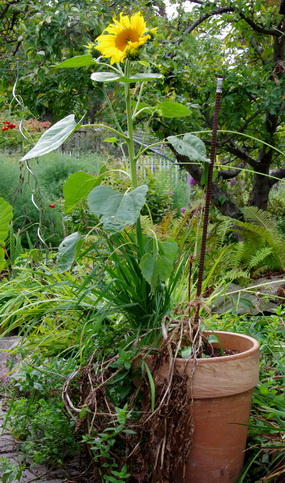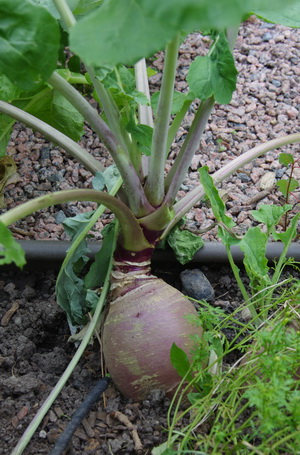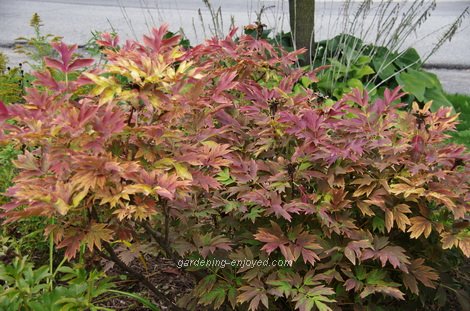| Back to Back Issues Page |
 |
|
Dallying In The Dirt, Issue #235--- A good crop of Rutabagas are making a dinner time appearance. October 05, 2015 |
 Here is another of my dilemmas. The container of Potatoes is ready to harvest. The Potato plants have long since died down and are hanging over the side of the pot but this amazing Sunflower has sprouted up surrounded by a clump of dense grass. I suspect these are items that somehow wandered, by themselves or by squirrel power, from the bird feeder to the Potato pot. I cannot bring my self to destroy that lovely Sunflower and I know the Potatoes will wait patiently for me in their cozy warm soil. By some definitions, I could see this Sunflower as a weed, I didn’t plant it and I really don’t want it in that pot but gardening is about recognizing the beauty that Mother Nature provides in her own time and locations.
Here is another of my dilemmas. The container of Potatoes is ready to harvest. The Potato plants have long since died down and are hanging over the side of the pot but this amazing Sunflower has sprouted up surrounded by a clump of dense grass. I suspect these are items that somehow wandered, by themselves or by squirrel power, from the bird feeder to the Potato pot. I cannot bring my self to destroy that lovely Sunflower and I know the Potatoes will wait patiently for me in their cozy warm soil. By some definitions, I could see this Sunflower as a weed, I didn’t plant it and I really don’t want it in that pot but gardening is about recognizing the beauty that Mother Nature provides in her own time and locations.  Rutabagas. You may want to call them Turnips. Turnips, to me, are a small round white vegetable that we harvest in early summer and sometimes a second crop in early fall. Rutabagas provide those large purple skinned roots that we can keep in our cold cellars for part of the winter. I used to really dislike the bowl of orange mush that was offered at every Thanksgiving dinner, at Grandma’s house. Each year I have been more successful at growing them and this year has seen a rather good crop developing in the these cooling days of autumn. I have learned to cook them. They usually get chopped into large chunks and smeared with a little butter and then wrapped in aluminum foil and tossed onto the barbeque for about 45 minutes. That package often includes some Potatoes and occasionally some Onions as well. Last night there were a few sprigs of Rosemary
included. All quite delicious. Having been away from the garden for a little over two weeks, there is a long list of chores awaiting me and the task of deciding where to start is often the biggest job of the day. Planting some of the new bulbs is always a good start and there are some exciting new varieties that will keep us anticipating their blooms through the dark winter months.
Rutabagas. You may want to call them Turnips. Turnips, to me, are a small round white vegetable that we harvest in early summer and sometimes a second crop in early fall. Rutabagas provide those large purple skinned roots that we can keep in our cold cellars for part of the winter. I used to really dislike the bowl of orange mush that was offered at every Thanksgiving dinner, at Grandma’s house. Each year I have been more successful at growing them and this year has seen a rather good crop developing in the these cooling days of autumn. I have learned to cook them. They usually get chopped into large chunks and smeared with a little butter and then wrapped in aluminum foil and tossed onto the barbeque for about 45 minutes. That package often includes some Potatoes and occasionally some Onions as well. Last night there were a few sprigs of Rosemary
included. All quite delicious. Having been away from the garden for a little over two weeks, there is a long list of chores awaiting me and the task of deciding where to start is often the biggest job of the day. Planting some of the new bulbs is always a good start and there are some exciting new varieties that will keep us anticipating their blooms through the dark winter months.Now it’s time to answer a few of my reader’s questions. Don’t forget to check the front page of the Website for frequent short ideas for current gardening activities. David Asks? When are you going to take your favourite son-in-law to California? I will even carry your camera equipment! |
| Back to Back Issues Page |
